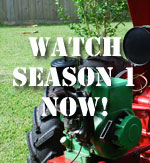
As you may know by now, there have been several changes in the DB project tractor. One of the largest changes is the engine swap to a newer 3 HP Briggs & Stratton engine. In the episodes, I did not shed any light on this fact. If you are paying close attention, then you will notice that in the course of the shows, there have been 3 different engines used. All the Briggs and garden tractor aficionados are already on top of this and have made note. I used the various engines to illustrate the various tasks and steps in the process in an engine repair/rebuild, but it was not necessary that they be the exact same engine. That being said, I had a challenge facing me. With the new engine, I was using the old engine’s carburetor system. I had to make several adjustments to make it work. Here were the problems-
- the mounting screws were 90 degrees opposite on the newer engine.
- the linkage for the governor was completely dissimilar, and no common parts could be used.
- the linkage from the old engine for the throttle could not be used.
So, let me go through these one at a time to show you how I dealt with these problems. Also, if you are a beginner, such problems will make it feel like the project is too daunting for you to tackle. But really this is not the case. You just have a puzzle with a couple of missing pieces. So make your own! Let’s look at it together.
First problem- the carburetor mounting screws- I thought of 2 solutions to this problem: The first was to cut the bracket, turn it 90 degrees and weld it back on. This would have worked fine, but these are antique parts, and something in me did not want to cut an antique part. Plus, as you saw in the welding episode, my welding skills are not yet at a level where I could feel like I could do a good job. So, the second solution I came up with was to create an adapter, thus leaving all other parts in their original condition. This seemed like a simpler solution. Keep you solutions as simple as you can- there will be less problems down the road. Well, this was the solution I decided on. All I needed was a metal donut with 4 holes in it. Well, my simple solution still had a few problems- two of the holes would have to be threaded, and on the other two they would have to fit flush, which meant counter-sunk holes. No problem, just get the drill press out and some tap and dies. I designed the piece to look like this- [graphic] Well I shared it with a buddy of mine who has a machine shop, and he said he could turn the part out of aluminum, and take care of the hole special needs. So, I bought him a beer and he made me the part! It came out perfect. I got lucky, he made it very precise, and it works beautifully.  Now, my plan to make it myself at the drill press would have done just fine, but it would not have been as nice for sure. Let me not forget to do something nice for him in return. Thanks Kelly! So the adapter worked beautifully, and now I have the carburetor mounted on the engine. Now, none of the linkage will fit- on top of the fact that the linkages from both engines are completely different. On to the next problem-
Now, my plan to make it myself at the drill press would have done just fine, but it would not have been as nice for sure. Let me not forget to do something nice for him in return. Thanks Kelly! So the adapter worked beautifully, and now I have the carburetor mounted on the engine. Now, none of the linkage will fit- on top of the fact that the linkages from both engines are completely different. On to the next problem-
Let’s make our own linkage! So, I had to understand what the governor was doing in order to make the new linkage. Basically, the governor opens and closes the throttle as needed to maintain the same engine speed. That may be over-simplifying it a little, but look at it this way- when your lawn mower is on the driveway, there is no load on the engine. The governor retards the engine so it doesn’t go too fast and blow itself up. Then you roll into the grass, and it starts cutting. Now the load is high, and the throttle has to open to take the load, keep the speed, and not die. Got it? I had to find the simplest governor linkage I could to duplicate. That is when I went to my friends at www.gardentractortalk.com and asked for help.  (find yourself a good forum that pertains to your project. They will make your life much easier.) After explaining my problem, one of the members- Lauber1- sent me this image of an old governor system that I could duplicate and fabricate out of wire and parts I had. Here is the image- what could be simpler? I could handle that. Now, my engine has a wind vane, but not the little arm on it. So, I used some Castaloy and soldered an arm on it, estimating the length, and taking into consideration the thickness of the adapter. Here is the result- [see images below] Now all I needed to do is tie it to the throttle arm and wala! A governor! I used some safety wire. Safety wire is stainless steel, and is used on aircraft to wire all the nuts and bolts so they cannot work themselves loose. An aircraft mechanic I know gave it to me years ago, and I use it for all kinds of stuff. But, any stiff wire would do in this application.
(find yourself a good forum that pertains to your project. They will make your life much easier.) After explaining my problem, one of the members- Lauber1- sent me this image of an old governor system that I could duplicate and fabricate out of wire and parts I had. Here is the image- what could be simpler? I could handle that. Now, my engine has a wind vane, but not the little arm on it. So, I used some Castaloy and soldered an arm on it, estimating the length, and taking into consideration the thickness of the adapter. Here is the result- [see images below] Now all I needed to do is tie it to the throttle arm and wala! A governor! I used some safety wire. Safety wire is stainless steel, and is used on aircraft to wire all the nuts and bolts so they cannot work themselves loose. An aircraft mechanic I know gave it to me years ago, and I use it for all kinds of stuff. But, any stiff wire would do in this application.

Preparing to weld with Castaloy |

Clamp with vise grips |

End Results |

Close-up with spring attached |

Full view with spring rough attached |

detail view of linkage |
Now we have the carburetor installed, and the governor hooked up. Now we have to control this mess with the throttle, right? And I am looking, and nothing matches up, and there aren’t any parts to make it work. No problem! I’ll make my own! First, I needed to mount the throttle cable somewhere that would be secure, and would not bind the cable and would be in reach of the throttle mechanism. There was a bracket of some kind on the engine already, and it was used for nothing before. I could tell, because there were no signs on the paint being disturbed. I guess this was meant for something on another device, and was left in place at the factory. Well, looking at it, it seemed like the perfect place to mount the cable. It had a screw that would hold the cable well, so I decided that this would be perfect. Now, with the cable in place, I had to figure out how to get the movement of the cable up and down to open and close the throttle- let me qualify this- the throttle is not connected to the cable directly. All the cable does is put more or less tension on the throttle spring, depending on whether you have it at the low or high setting. The cable does this with the spring. The less tension on the spring the more the governor will open the throttle. It is a kind of tug of war. I could see that I needed an arm of some kind with a the spring on one side, and the cable on the other. This little arm would need a place to be mounted, and there wasn’t any. I went down to the hardware store, and got some aluminum stock. I cut a piece of with my hack saw to make the bracket out of, and I located some nearby screws on the engine I could use to mount it to. [see images below]
|

Metal blank to make bracket
|

Bracket ready to install
|

Bracket installed and cable attached |

Linkage Assembled
Using my drill, grinder, files and pliers I shaped the new bracket to fit. I could have used steel, but the aluminum was plenty strong, and easier to drill, grind and file. I shaped the little arm, put a nut a bolt through it with some washers between, and it was ready to mount. I put the cable in place. I put the carburetor back on, attached the spring and the governor, and it was ready for testing. Here is the end result. This may be too much detail for some folks, so I left it out of the video episodes. But to those working with an engine like this, it might be a helpful reference. Good projecting!

















